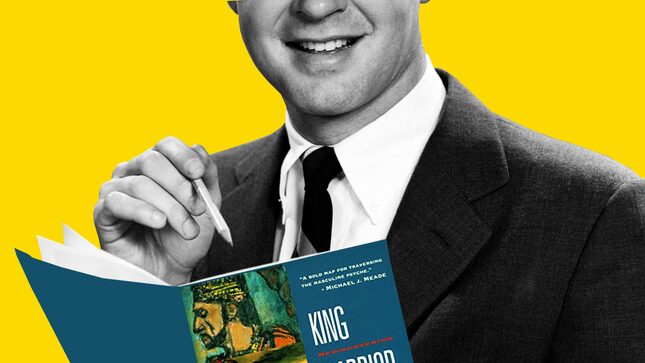King, Warrior, Magician, Revisionist: The Enduring 'Masculine' Book That Romanticizes Cro-Mags
In DepthIn Depth
Illustration: Elena Scotti (Photos: Getty Images, Amazon)
A few weeks ago, the popular YouTuber and “strongman” Elliott Hulse posed in an Instagram photo with a shotgun resting against his shoulder. “There’s an attack on masculinity,” the caption read. He went on to write that “men are being feminized, emasculated, and sterilized in the womb.” The post was a promotion for Hulse’s coaching program for men, which is guided by the framework of four key archetypes for manhood: king, warrior, magician, and lover. In a recent Instagram story, he barked at the camera while holding that gun again, “If you want to join a group of likeminded men… message me the word ‘king.’”
This time, he cocked the gun for dramatic effect.
Hulse’s coaching program appears influenced by the 1990 book King, Warrior, Magician, Lover: Rediscovering the Archetypes of the Mature Masculine, and he isn’t alone. The book, a spirituality title that hit the bestseller list at publication, is now enjoying renewed popularity within the thriving realm of Instagram-savvy self-help gurus focused on the topic of masculinity. Its influence is evident in everything from specialized “magician” workshops to YouTube guidance on “becoming a KING” to a one-day “warrior training.” Currently, it ranks as an Amazon No. 8 bestseller in the category of “Men’s Gender Studies,” just behind Neil Strauss’s The Game and John Gray’s Men Are from Mars, Women Are from Venus.
Its influence is evident in everything from specialized “magician” workshops to YouTube guidance on “becoming a KING”
The book isn’t just beloved by men waving around guns on social media. King, Warrior, Magician, Lover is also embraced by long-haired men who carry wooden staffs, beat drums in the desert, and talk about “inner work.” Three decades after it was published by Robert Moore and Douglas Gillette—a psychoanalyst and mythologist, respectively—the book has found a diverse new audience of seekers. This is despite the fact that Moore in 2016 murdered his wife before dying by suicide.
In light of its enduring and broad-based cachet, I decided to read King, Warrior, Magician, Lover, not as a historical relic, but as a reflection of the models of masculinity that are gaining traction these days. I found a book that, although written in the early nineties, was thoroughly disinterested in reimagining the future of masculinity. Instead, it gazes longingly backward to the distant, and fictive, past. That is to say nothing of its unapologetic gender essentialism, heteronormativity, and cultural appropriation—as well as poetic reveries about cavemen. These are among the same concerns raised by feminists back in the nineties in response to the rising “mythopoetic men’s movement,” which popularized weekend retreats where privileged men traveled into the woods and went “wild,” and of which this book was a major influence.
Here we are, again. Still.
Published in 1990, King, Warrior, Magician, Lover decried a “crisis in masculine identity of vast proportions” in which it feels “increasingly difficult to point to anything like either a masculine or a feminine essence.” This was not an optimistic, progressive celebration of a needed move away from gender essentialism, but rather a distressed call for a return to it. As Moore and Gillette saw it, this so-called crisis of blurred delineations was a result of the “breakdown of the traditional family,” in which an absent father “wreaks psychological devastation,” damaging “both his daughters’ and his sons’ ability to achieve their own gender identity and to relate in an intimate and positive way with members both of their own sex and the opposite sex.”
But it hurt grown men, most especially. They argued that men were “overwhelmed by the feminine” and missing “an adequate connection to the deep and instinctual masculine energies, the potentials of mature masculinity.” Moore and Gillette saw feminism as partly to blame for leveling “critique upon what little masculinity [men] could still hold onto for themselves.” They held a moralistic and conventional vision of the ultimate reward for achieving adequate masculine connection: “Monogamy… can be seen as the product of a man’s own deep rootedness and centeredness,” they wrote. (Of course, the book was also fundamentally heteronormative and homophobic, given the veneration of the “traditional family” and the critique of fatherless households.)
-

-

-

-

-

-

-

-

-

-

-

-

-

-

-

-

-

-

-

-

-

-

-

-

-

-

-

-

-

-

-

-

-

-

-

-

-

-

-

-








































